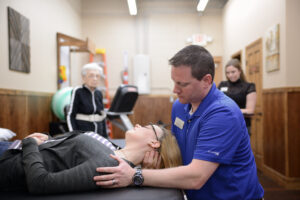 By: Jason Grandone, MS, PT, Regional Manager at ApexNetwork Physical Therapy
By: Jason Grandone, MS, PT, Regional Manager at ApexNetwork Physical Therapy
There are many causes of vertigo, a whirling or spinning sensation in which an individual inappropriately experiences the perception of motion. However, benign paroxysmal positional vertigo (BPPV), which is caused by displacement of crystals from the innermost part of the ear into one of 3 semicircular canals, is responsible for 20% of all vertigo, and 50% of all vertigo in individuals over the age of 50.
Typical symptoms of BPPV include a sensation of the room spinning when an individual puts their head in a specific position. Often it occurs when a patient lays down or rolls over in bed, when laying back to have their hair washed or teeth cleaned, or simply when they bend over to tie their shoes. For some people these symptoms can be mild, while for others they can be debilitating, causing extreme dizziness, nausea, and even vomiting. Your physical therapist can perform simple tests to determine which ear is affected, and then can perform a series of head positions, or maneuvers, to relocate the crystals back to the inner ear where they belong.
While it is not always known why this type of vertigo occurs (50% of cases have no known cause of onset), positional vertigo can be the result of a head injury or fall, a virus that affects the inner ear, or simply the natural degeneration of the vestibular system with aging. If you have symptoms of vertigo, notify your medical provider. Your provider can help determine whether positional vertigo may be the cause and refer you for physical therapy treatment. Treatment is up to 80% effective and can restore normal function, typically in just a couple of sessions.
References:
Hain, TC. http://www.dizziness-and-hearing.com. 27 December 2006
Benign paroxsymal positional vertigo. Otolaryngology Head and Neck Surgery, Vol 139, No 5S4, November 2008
Vestibular Disorders Association. http://vestibular.org


